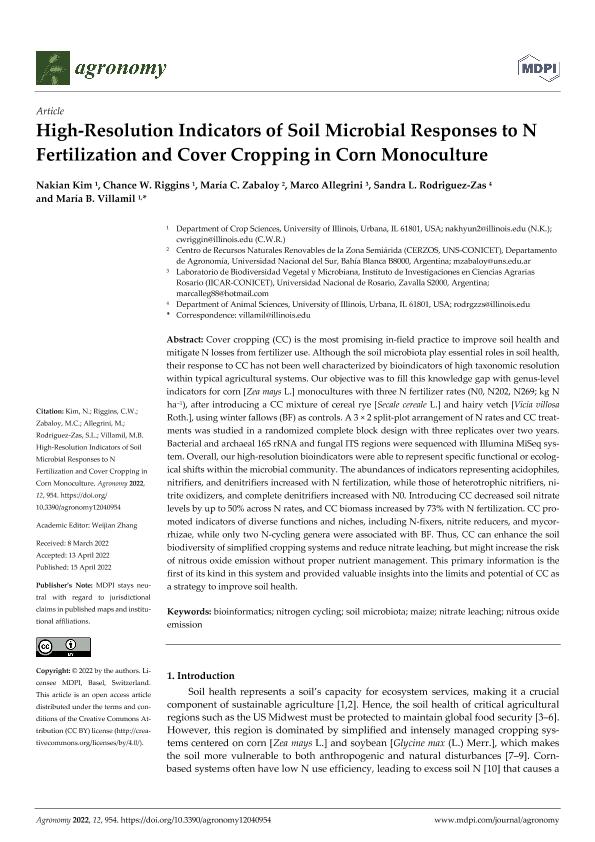Artículo
High-Resolution Indicators of Soil Microbial Responses to N Fertilization and Cover Cropping in Corn Monoculture
Kim, Nakian; Riggins, Chance W.; Zabaloy, Maria Celina ; Allegrini, Marco
; Allegrini, Marco ; Rodriguez Zas, Sandra L.; Villamil, Maria Bonita
; Rodriguez Zas, Sandra L.; Villamil, Maria Bonita
 ; Allegrini, Marco
; Allegrini, Marco ; Rodriguez Zas, Sandra L.; Villamil, Maria Bonita
; Rodriguez Zas, Sandra L.; Villamil, Maria Bonita
Fecha de publicación:
15/04/2022
Editorial:
MDPI
Revista:
Agronomy
e-ISSN:
2073-4395
Idioma:
Inglés
Tipo de recurso:
Artículo publicado
Clasificación temática:
Resumen
Cover cropping (CC) is the most promising in-field practice to improve soil health and mitigate N losses from fertilizer use. Although the soil microbiota play essential roles in soil health, their response to CC has not been well characterized by bioindicators of high taxonomic resolution within typical agricultural systems. Our objective was to fill this knowledge gap with genus-level indicators for corn [Zea mays L.] monocultures with three N fertilizer rates (N0, N202, N269; kg N ha−1), after introducing a CC mixture of cereal rye [Secale cereale L.] and hairy vetch [Vicia villosa Roth.], using winter fallows (BF) as controls. A 3 × 2 split-plot arrangement of N rates and CC treatments was studied in a randomized complete block design with three replicates over two years. Bacterial and archaeal 16S rRNA and fungal ITS regions were sequenced with Illumina MiSeq system. Overall, our high-resolution bioindicators were able to represent specific functional or ecological shifts within the microbial community. The abundances of indicators representing acidophiles, nitrifiers, and denitrifiers increased with N fertilization, while those of heterotrophic nitrifiers, nitrite oxidizers, and complete denitrifiers increased with N0. Introducing CC decreased soil nitrate levels by up to 50% across N rates, and CC biomass increased by 73% with N fertilization. CC promoted indicators of diverse functions and niches, including N-fixers, nitrite reducers, and mycorrhizae, while only two N-cycling genera were associated with BF. Thus, CC can enhance the soil biodiversity of simplified cropping systems and reduce nitrate leaching, but might increase the risk of nitrous oxide emission without proper nutrient management. This primary information is the first of its kind in this system and provided valuable insights into the limits and potential of CC as a strategy to improve soil health.
Archivos asociados
Licencia
Identificadores
Colecciones
Articulos(CERZOS)
Articulos de CENTRO REC.NAT.RENOVABLES DE ZONA SEMIARIDA(I)
Articulos de CENTRO REC.NAT.RENOVABLES DE ZONA SEMIARIDA(I)
Citación
Kim, Nakian; Riggins, Chance W.; Zabaloy, Maria Celina; Allegrini, Marco; Rodriguez Zas, Sandra L.; et al.; High-Resolution Indicators of Soil Microbial Responses to N Fertilization and Cover Cropping in Corn Monoculture; MDPI; Agronomy; 12; 4; 15-4-2022; 1-26
Compartir
Altmétricas



